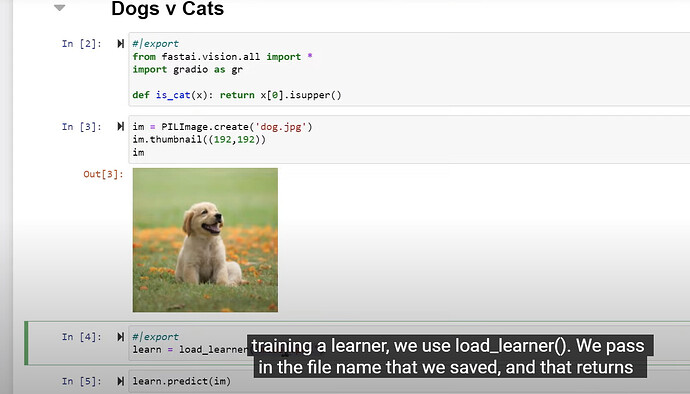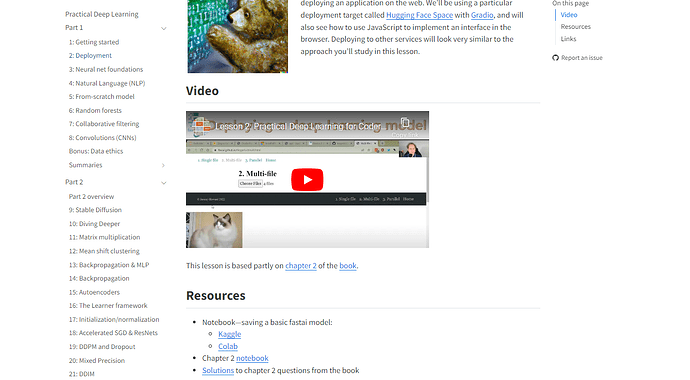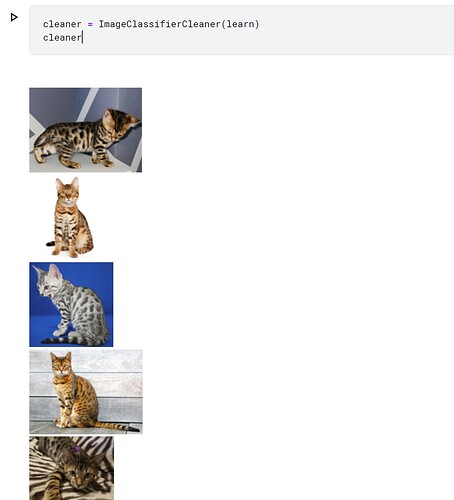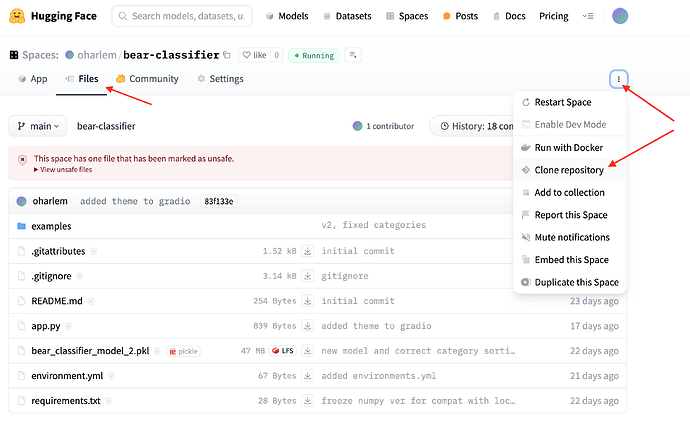i wiil be happy for someone to send me a link for the Dog V Cats notebook
41:32 on the lecture
Hello @wsaujanya,
The thread here is quite useful for troubleshooting issues with the ImageClassifierCleaner, and yes, your browser may be an issue.
What it does not mention and what helped me when my ImageClassifierCleaner wasn’t working is that it might be a compatibility issue between the ImageClassifierCleaner module and Torch, which you can get around by installing an older version of PyTorch:
!pip uninstall torch torchvision torchaudio
!pip install torch==2.3.1 torchvision==0.18.1
import torch
print(torch.__version__)
2.3.1 was the latest version I found worked. If you don’t install the correct version of torch and torchvision it’ll give you a warning about their codependencies but these two worked.
Hope this helps.
I believe I was receiving a similar error when I was running mine and installing an older version of Torch cleared it. Has doing that not worked for you?
Thanks…
Wasn’t able to clean data after running the model at all.
Will revisit the same topic once again on a different browser.
Hi all,
Posting my very basic image classifier. Very simple compared to other classifiers posted here but its a start.
I got stuck trying to use Gitbash then git desktop. I then realised I could bypass these by using the file upload functionality in the Hugging Faces Spaces GUI. Much easier. I will learn git in the future.
Wow congratulations @oharlem this works really well. I have a lot to learn. Would you mind sharing your source code please? Also - sounds like you have found a switch to use GPU - is this a setting in Colab, Kaggle?
Thanks
hey @diggooddog
thanks
> Would you mind sharing your source code please?
Sure thing. The repo is actually in Huggingface Files area of the app.
You can
git clone git@hf.co:spaces/oharlem/bear-classifier
It’s location:
>sounds like you have found a switch to use GPU - is this a setting in Colab, Kaggle?
Yep, used Colab. There you can change runtime type to select GPU.
Best
D.
Many thanks - sorry should have been more clear - was actually after the code used to create and train the model pre-pkl if you are willing to share please. I couldn’t see it in the hugging face files.
Ah, sure, try this: fastai-lesson2-bear-classifier2.ipynb · GitHub
Apologies if this was already asked and answered (I’ve searched through this topic to no avail). In the lesson Jeremy is setting a seed for a random number generator to get the very same validation set each time, to be able to test what is the effect of all the levers (eg. number of epochs or resizing method) on the final model. Does this random seed setting affect also random augmentations being applied in the bear classifier example? In other words are the augmentations exactly the same each time the notebook is being rerun?
Great thanks
Hi! I want to share my progress in the second module using a brain tumor classification
Hi I am going though Module 2 and am confused by something.
My understanding of item tfms is that the transformation is applied per item basis while if we use the batch tfms the transformation is applied on a batch basis.
My doubt arises from this example
bears = bears.new(item_tfms=Resize(128), batch_tfms=aug_transforms(mult=2)) #if batch allies by batch, should the output not be same as we are using same image. Or does the randopm parameters chosen for each item and not the whole batch?
dls = bears.dataloaders(path)
dls.train.show_batch(max_n=8,nrows=2,unique=True)
As we are using Unique = True the same item is passed though for the batch transofrmation. My expection is that all itemas are being subjected to same transformation and the output would be the same. (8 bears of same type) but the output i got and the one in the notebook shows diffrent transformation being applied to same image.
So i though ok maybe the randomness is diffrent for each iteam but from a processign point of view the transformation take place in parallel.
To test this i tried the following code sample.
bears = bears.new(batch_tfms=RandomResizedCrop(128, min_scale=0.3))
dls = bears.dataloaders(path)
dls.train.show_batch(max_n=6, nrows=1, unique=True) #unique means if we want toi pull n entries of same item
Alas the output is 6 bears of same type.
Is random resize, not Random?
Can someone please help me with my doubt.
Me too. Only way I could move forwards was to retrace the steps back to the image downloads and rerun them and then everything was fine
Good luck
Regards Jon
Hi
I have started doing this course and its really great!
I already have conda installed. Should I uninstall and reinstall using fastSetup with mambaforge rather than conda?
Thanks so much
I think you should be fine. It’s most important to just get started. I quite like devcontainers or wsl2.
With devcontainers you can keep tweeting the environment over time as you learn more and more.
Happy to share if interested.
Thanks so much.
Yes I’m definitely interested to to learn more about your approach
You can download the version I used for a previous project from fastai_pet_clasifier/.devcontainer at master · CraigRichards/fastai_pet_clasifier · GitHub
If you have any issues please let me know, sometimes I make adjustments and don’t always rebuild the container to test.
Should get you going with Docker and DevContainers.



